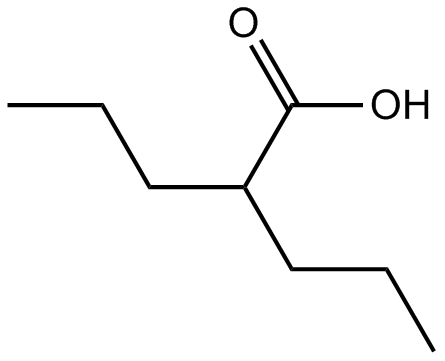Valproic acid (Synonyms: NSC 93819, 2-Propylvaleric Acid, Valproate, VPA) |
| Katalog-Nr.GC11424 |
HDAC1-Inhibitor
Products are for research use only. Not for human use. We do not sell to patients.

Cas No.: 99-66-1
Sample solution is provided at 25 µL, 10mM.
Valproic acid is an inhibitor of HDAC1 with IC50 value of 0.4mM [1].
Valproic acid (VPA) is a branched short-chain fatty acid. It is previously synthesized and used as an inert solvent of organic compounds. VPA is then found to have ability in preventing pentylenetetrazol-induced convulsions in rodents. It is used as an antiepileptic drug via inhibiting the activity of GABA. VPA is found to inhibit the degradation of GABA and increase GABA synthesis as well as inhibit GABA Transaminobutyratre. It also blocks Na+ channels, Ca2+ channels and voltage-gated K+ channels. Besides that, VPA is reported as an inhibitor of HDAC, making it to be a potential therapeutic for cancers. VPA inhibits HDAC1 in vitro with IC50 value of 0.4mM. For nuclear extracts from HeLa cells, VPA inhibits HDACs with IC50 values from 0.5mM to 2mM [1, 2].
References:
[1] Phiel C J, Zhang F, Huang E Y, et al. Histone deacetylase is a direct target of valproic acid, a potent anticonvulsant, mood stabilizer, and teratogen. Journal of Biological Chemistry, 2001, 276(39): 36734-36741.
[2] Chateauvieux S, Morceau F, Dicato M, et al. Molecular and therapeutic potential and toxicity of valproic acid. BioMed Research International, 2010, 2010.
Average Rating: 5 (Based on Reviews and 31 reference(s) in Google Scholar.)
GLPBIO products are for RESEARCH USE ONLY. Please make sure your review or question is research based.
Required fields are marked with *




















